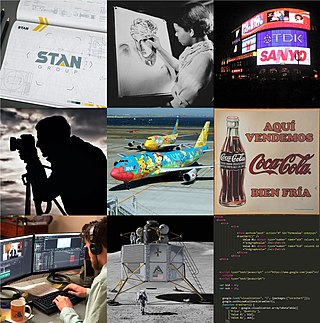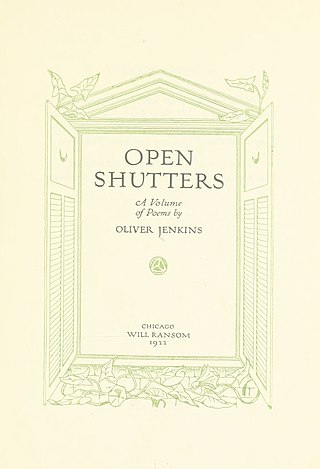Related Research Articles

Graphic design is a profession, academic discipline and applied art whose activity consists in projecting visual communications intended to transmit specific messages to social groups, with specific objectives. Graphic design is an interdisciplinary branch of design and of the fine arts. Its practice involves creativity, innovation and lateral thinking using manual or digital tools, where it is usual to use text and graphics to communicate visually.

A category of fine art, graphic art covers a broad range of visual artistic expression, typically two-dimensional, i.e. produced on a flat surface. The term usually refers to the arts that rely more on line, color or tone, especially drawing and the various forms of engraving; it is sometimes understood to refer specifically to printmaking processes, such as line engraving, aquatint, drypoint, etching, mezzotint, monotype, lithography, and screen printing. Graphic art mostly includes calligraphy, photography, painting, typography, computer graphics, and bindery. It also encompasses drawn plans and layouts for interior and architectural designs.
Communication design is a mixed discipline between design and information-development concerned with how media communicate with people. A communication design approach is concerned with developing the message and aesthetics in media. It also creates new media channels to ensure the message reaches the target audience. Due to overlapping skills, some designers use graphic design and communication design interchangeably.

Motion graphic design, also known as motion design, is a subset of graphic design which combines design with animation and/or filmmaking, video production, and filmic techniques. Examples include kinetic typography and graphics used in film and television opening sequences, and station identification logos of some television channels.

April Greiman is an American designer widely recognized as one of the first designers to embrace computer technology as a design tool. Greiman is also credited, along with early collaborator Jayme Odgers, with helping to import the European New Wave design style to the US during the late 70s and early 80s." According to design historian Steven Heller, “April Greiman was a bridge between the modern and postmodern, the analog and the digital.” “She is a pivotal proponent of the ‘new typography’ and new wave that defined late twentieth-century graphic design.” Her art combines her Swiss design training with West Coast postmodernism.

Steven Heller is an American art director, journalist, critic, author, and editor who specializes in topics related to graphic design.
Nigel Holmes is a British/American graphic designer, author, and theorist, who focuses on information graphics and information design.
Woodrow Phoenix is a British comics artist, writer, editorial illustrator, graphic designer, font designer and author of children's books.

Print is an American design and culture website that began as Print, A Quarterly Journal of the Graphic Arts, in 1940, and continued publishing a physical edition through the end of 2017 as Print.

Redmond Aksel Simonsen was an American graphic artist and game designer best known for his work at the board wargame company Simulations Publications, Inc. (SPI) in the 1970s and early 1980s. Simonsen was considered an innovator in game information graphics, and is credited with creating the term "game designer".
Rick Poynor is an English writer on design, graphic design, typography, and visual culture.

Ellen Lupton is a graphic designer, curator, writer, critic, and educator. Known for her love of typography, Lupton is the Betty Cooke and William O. Steinmetz Design Chair at Maryland Institute College of Art. Previously she was the Senior Curator of Contemporary Design at Cooper Hewitt, Smithsonian Design Museum in New York City and was named Curator Emerita after 30 years of service. She is the founding director of the Graphic Design M.F.A. degree program at Maryland Institute College of Art (MICA), where she also serves as director of the Center for Design Thinking. She has written numerous books on graphic design for a variety of audiences. She has contributed to several publications, including Print, Eye, I.D., Metropolis, and The New York Times.
Lorraine Wild is a Canadian-born American graphic designer, writer, art historian, and teacher. She is an AIGA Medalist and principal of Green Dragon Office, a design firm that focuses on collaborative work with artists, architects, curators, editors and publishers. Wild is based in Los Angeles, California.

James Burkey Belser was an American graphic designer. He is best known for his design of the nutrition facts label, the U.S. Food and Drug Administration (FDA) mandated food labeling system that appears on all packaged foods in the United States, which has been called by some "the most frequently reproduced graphic in the world." He is also widely known for the pioneering work in legal advertising that earned him a Lifetime Achievement Award from the Legal Marketing Association as well as induction into that organization's Hall of Fame.
Peter Seitz was a graphic designer, author, teacher and business owner who served as the first design director at The Walker Art Center, and helped establish the graphic design program at the Minneapolis College of Art and Design.
Ecco Domani is the brand of an Italian wine company selling in the United States, Canada, and Northern Europe, with marketing and distribution by E & J Gallo Winery. It was founded in 1996 and is led by Fabrizio Gatto. Market Watch named it one of the "hot brands" in 1998. It reportedly produces the top imported Italian pinot grigio in the United States.

Will Ransom was an American graphic designer, letterer, typeface designer, and the foremost bibliographer of private presses.
Robert Freeman Asleson was an American publisher who was a major contributor to the publishing, library and information industries. He led a number of key information companies as they evolved from print, to microfilm, to mainframe, CD-ROM and then web based databases. He also brought professional management to entrepreneurial library companies. Some of these organizations are now among the titans of the library industry.
Jaques (Jack) Cattell was an American publisher and founder of a company bearing his name, "Jaques Cattell Press, Inc.," based in Lancaster, Pennsylvania.
Edward Howard Betts was an American painter, collagist, author, and teacher. He was known for his abstract paintings which he developed using an improvisational method. He was also an accomplished painter of realistic watercolors. Betts published three instructional books on painting and taught at the University of Illinois.
References
- ↑ http://rmc.library.cornell.edu/EAD/pdf_guides/RMA01416.pdf | Honor designs, 1950-1951, p.115 | accessdate = 2012-02-05
- ↑ Conrad Taylor, 'Training the design militia: in-service design education for the non-professional practitioner', paper delivered at the Information Design Conference, Cambridge, England, 14–15 July 1997 | "Archived copy" (PDF). Archived from the original (PDF) on 2010-10-08. Retrieved 2012-02-08.
{{cite web}}: CS1 maint: archived copy as title (link) | accessdate = 2012-02-08 - ↑ Beth Mazur, 'Information design in motion', in Michael J. Albers, Beth Mazur (ed.s), Content & complexity: information design in technical communication, Routledge, 2003, p.18
- ↑ www.janvwhite.org http://www.janvwhite.org/ . Retrieved 2015-01-03.
{{cite web}}: Missing or empty|title=(help)[ title missing ] - ↑ "Mel Alexenberg: Cyberangels". Archived from the original on 2012-11-09. Retrieved 2012-02-05. | accessdate = 2012-02-05
- ↑ "Designer". alexanderwwhite.wordpress.com. 23 June 2011. Retrieved 2012-02-05.
- ↑ www.westportnow.com http://www.westportnow.com/index.php?/v2_5/obitjump/jan_v._white_86/ . Retrieved 2015-01-03.
{{cite web}}: Missing or empty|title=(help)[ title missing ]